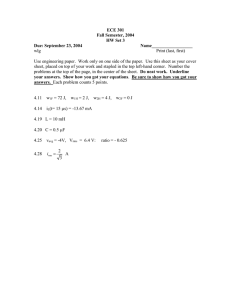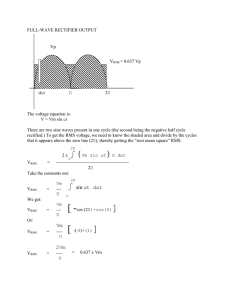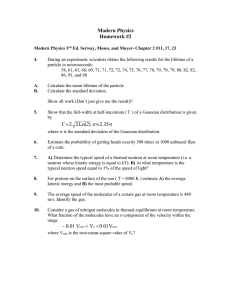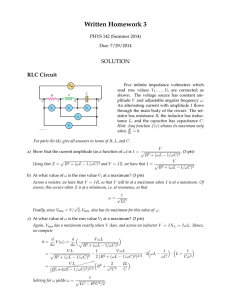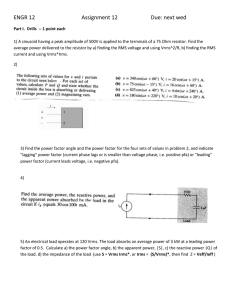week 11 - Electrical and Computer Engineering
advertisement
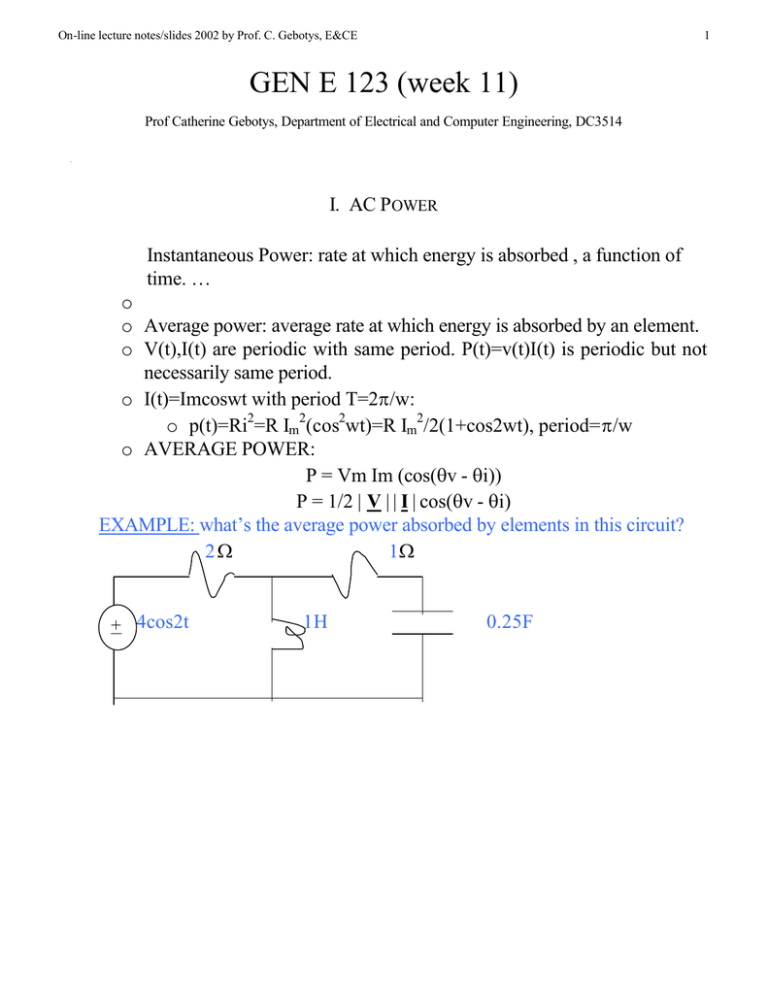
On-line lecture notes/slides 2002 by Prof. C. Gebotys, E&CE
1
GEN E 123 (week 11)
Prof Catherine Gebotys, Department of Electrical and Computer Engineering, DC3514
h
I. AC POWER
Instantaneous Power: rate at which energy is absorbed , a function of
time. …
o
o Average power: average rate at which energy is absorbed by an element.
o V(t),I(t) are periodic with same period. P(t)=v(t)I(t) is periodic but not
necessarily same period.
o I(t)=Imcoswt with period T=2π/w:
o p(t)=Ri2=R Im2(cos2wt)=R Im2/2(1+cos2wt), period=π/w
o AVERAGE POWER:
P = Vm Im (cos(θv - θi))
P = 1/2 | V | | I | cos(θv - θi)
EXAMPLE: what’s the average power absorbed by elements in this circuit?
2Ω
1Ω
+ 4cos2t
1H
0.25F
On-line lecture notes/slides 2002 by Prof. C. Gebotys, E&CE
2
o RMS Voltage/Current: the rms value is a constant equal to the dc current
(voltage) that would deliver the same average power to a resistance.
Vrms = Vm/[(2)0.5]
o AVERAGE POWER :
P = Vrms Irms cos(θv - θi)
P = | Vrms | | Irms | cos(θv - θi)
EXAMPLE: what’s the average power absorbed by load impedance?
2.65mH
+
325
cos377t
2Ω
50uF
30Ω
On-line lecture notes/slides 2002 by Prof. C. Gebotys, E&CE
3
o COMPLEX POWER:
S = Vrms Irms* = P + jQ
Where Irms* is a complex conjugate of rms current phasor [ie. (a+jb)* = a-jb
]. |S| is also called the apparent power. The real part of power, P, is the average
power(watts).
P = Re{1/Z}|Vrms|2 =Re{Y}|Vrms|2
The complex part of power, Q, is the reactive power (volt-amps) .
Q = |Vrms||Irms| sin(θv - θi)
EXAMPLE: Find the power into the load.
0.5F
+
50cost 3Ω
2Ω
1H
On-line lecture notes/slides 2002 by Prof. C. Gebotys, E&CE
o The ratio of average power to apparent power is the power factor:
Pf = P/[VrmsIrms ] = cos(θv - θi)
Note: (θv - θi) is the angle of impedance of the load.
EXAMPLE: A circuit has load of Z = 0.4 + j1.2. It gets its power from a 220
Vrms line (ie. 220∠0o ). Find the existing pf value. How can we CORRECT
the load to change the pf to 0.98? (we do this by adding an impedance in
parallel to make correction)
4
On-line lecture notes/slides 2002 by Prof. C. Gebotys, E&CE
Note : cos(θv - θi) = cos(θi - θv) , so we don’t know from pf if
(θv - θi) is > 0 or is < 0.
Therefore we use the term pf LAGGING or pf LEADING
Lagging : current lags voltage θi < θv
Leading: current leads voltage θi > θv
So, in previous example pf=0.98 and θi = -11.5 o , θv = 0, where pf lagging.
If we were to correct for pf leading then we’d use θi = +11.5 o ,
So :
EXAMPLE: An electrical load operates at 240Vrms. It absorbs an average power
of 8kW at a lagging power factor of 0.8.
(a) whats the complex power? (of the load)
(b) whats impedance of the load?(Z=?)
5
